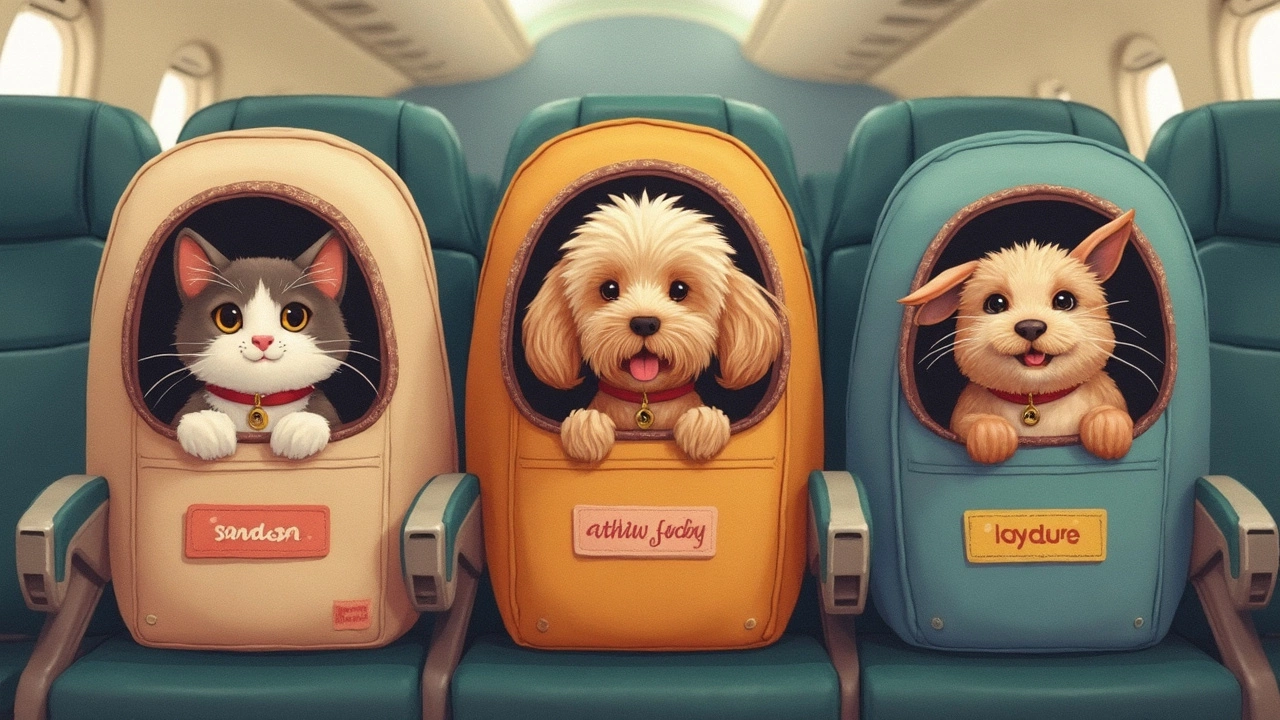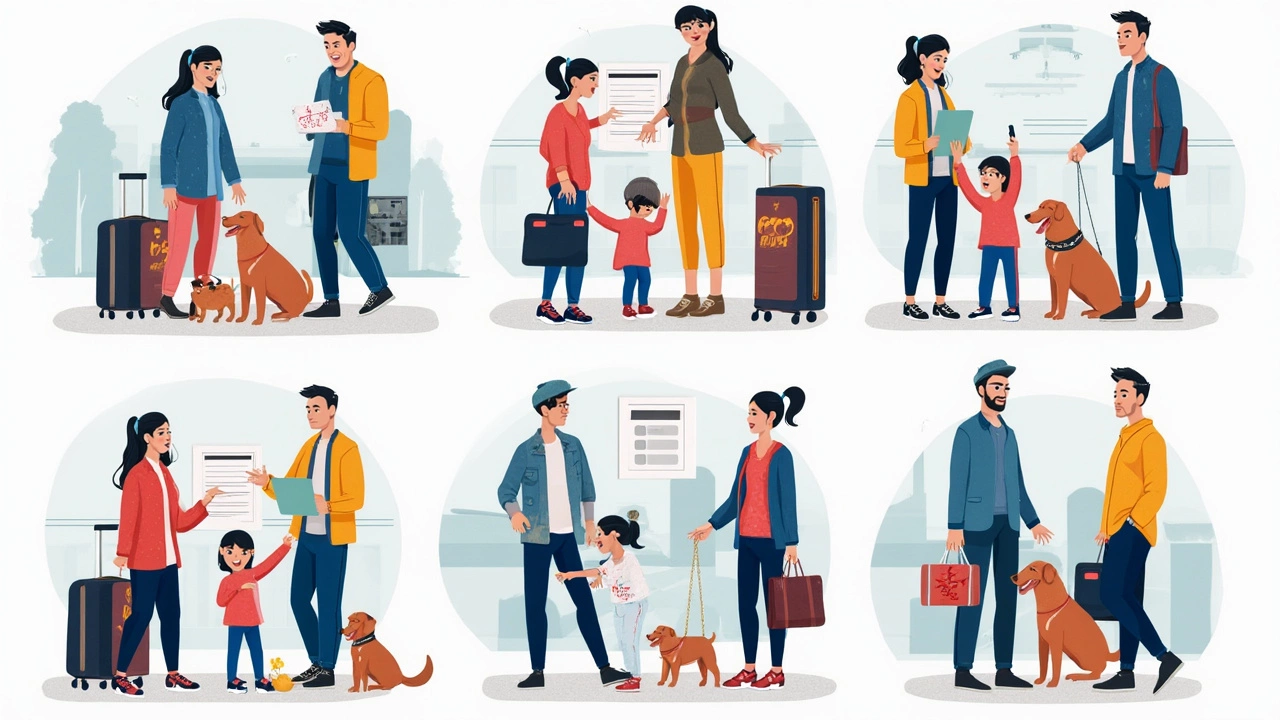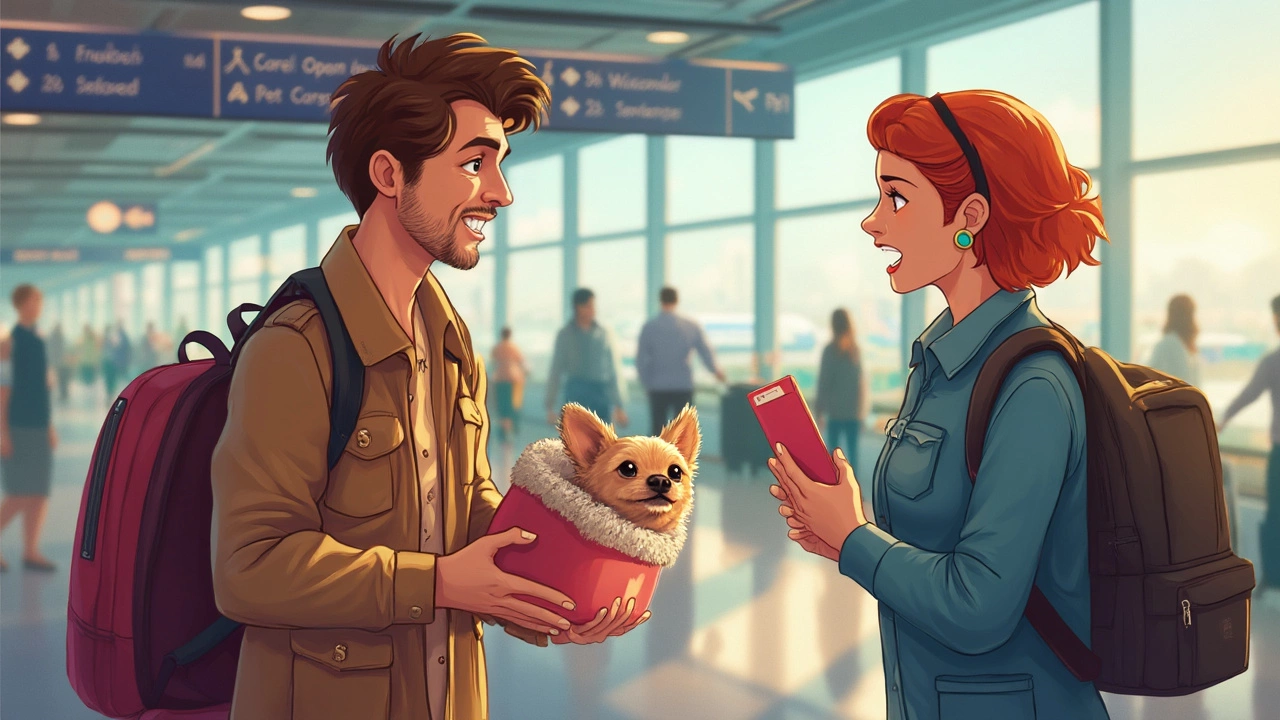Thinking about jetting off with your pet? Not every airline is happy to welcome your dog, cat, or parrot on board, and the rules can get confusing fast. Airlines have their own policies, fees, and even lists of banned animals. So, before you book, it pays to check what each carrier actually allows.
For example, Delta, American, and United let small dogs and cats ride with you in the cabin—if they fit in an airline-approved carrier under the seat. But some budget airlines, like Southwest and JetBlue, are famous for being more straightforward (and sometimes cheaper) about pet travel, sticking to only in-cabin pets. Want to bring a rabbit or a pet bird? Alaska Airlines stands out—they’ll carry a variety of animals in the cabin and cargo.
International travel is a different beast. Not all carriers allow pets on overseas routes, and some countries have very picky animal import rules. It’s easy to get tripped up by paperwork or miss a requirement—one missing document and your trip could fall apart at the airport. Double-check everything before booking that ticket, especially if your destination is outside North America.
- Which Airlines Allow Pets?
- Cabin vs. Cargo: Where Can Your Pet Ride?
- Breed and Size Restrictions
- Booking a Pet-Friendly Flight: Smart Tips
- Preparing Your Pet for Takeoff
Which Airlines Allow Pets?
Finding pet-friendly airlines isn’t as simple as it sounds. Each airline writes its own rules, which means you’ve got to check—it’s not enough to just show up with your pet and hope for the best.
Here’s a look at how some big-name U.S. airlines approach pet travel as of 2025:
- Delta Airlines: Dogs, cats, and even household birds can fly in-cabin on most domestic flights, as long as they fit in an approved carrier. No cargo for pets since COVID, though—cabin only.
- American Airlines: Allows small dogs and cats in-cabin for most flights under 12 hours. They also accept checked pets on certain routes but don’t allow short-nosed breeds in cargo.
- United Airlines: Welcomes small cats and dogs in-cabin. The PetSafe program (cargo for pets) was dropped in 2024, so it’s just in-cabin travel now.
- Southwest Airlines: Only allows small cats and dogs in-cabin, and only within the U.S. They keep the rules simple, but don’t offer any checked pet service.
- JetBlue: Cat or small dog in-cabin, yes; anything else, no. Each passenger can bring only one pet, and there’s a cap per flight—plan ahead!
- Alaska Airlines: Probably the champ for variety—dogs, cats, rabbits, and birds in-cabin, plus in the climate-controlled baggage area for longer or larger pets.
Not every airline allows every kind of pet or every travel situation. Say you’ve got a larger dog that can’t fit under the seat or want to bring a pet bird. In that case, Alaska Airlines is a solid bet, but you’re out of luck with Southwest or JetBlue. Internationally, things get even stricter—Air Canada and Lufthansa are known for being more flexible, but many European carriers won’t even let pets into the cabin at all.
If you’re curious about just how many pets actually travel by air, here’s a quick look at the 2024 stats from the U.S. Department of Transportation:
| Airline | Pets Carried (Cabin) | Pets Carried (Cargo) |
|---|---|---|
| Delta | 42,000 | 0 |
| American | 39,300 | 1,600 |
| United | 35,500 | 0 |
| Alaska | 20,700 | 2,200 |
| Southwest | 18,900 | 0 |
When booking, remember: flight routes matter. Some airlines let pets in the cabin for short domestic runs but not for long-haul or international flights. Cabin space for animals is limited, so seats for pets can actually sell out. If flying with a pet is a non-negotiable, book earlier than usual and call the airline to confirm everything.
Cabin vs. Cargo: Where Can Your Pet Ride?
Deciding whether your pet flies in the cabin or the cargo hold depends mostly on their size, breed, and the airline’s pet policy. Small pets usually get the VIP treatment — they can ride with you right under the seat in front. Big dogs (and sometimes cats or other animals that don’t fit under the seat) need to travel in the cargo area as checked baggage or air cargo.
Each airline sets its own rules. Usually, if your pet plus carrier weighs less than 15 to 20 pounds (about 7–9 kg), most US airlines like Delta, United, and American will let them travel in the cabin. Airlines like JetBlue and Southwest keep things simple: only small pets in the cabin, no checked pet program at all.
Here’s a quick breakdown of what to expect:
- Cabin: Pets must stay in a soft-sided, airline-approved carrier that fits under the seat. Only usually dogs, cats, and sometimes rabbits or birds (like on Alaska Airlines) are allowed. One pet per traveler is typical, and space is super limited, so you'll want to book early.
- Cargo: Larger pets, snub-nosed breeds, or animals not allowed up front ride in the aircraft hold. They need a hard-sided kennel, and the cargo area is pressurized but not as closely watched. Most airlines charge higher fees for this and, frankly, some pet owners find it stressful for their animals.
Worried about safety? Good news: the U.S. Department of Transportation tracks animal incidents. For 2023, airlines reported only 11 pet deaths and 10 injuries out of nearly 300,000 animals transported — a low rate, but one worth considering.
| Airline | In-Cabin Pets | Checked Pets |
|---|---|---|
| Delta | Yes (dogs, cats, small birds) | Yes (limited routes, restrictions apply) |
| United | Yes (dogs, cats) | Limited (PetSafe program paused on some routes) |
| Southwest | Yes (dogs, cats) | No |
| Alaska Airlines | Yes (dogs, cats, rabbits, birds) | Yes |
Always double-check which animals are actually allowed in the cabin or cargo. Some airlines put extra restrictions on breeds (like brachycephalic or "snub-nosed" pets), especially for cargo — there’s a genuine risk for breathing problems. If in doubt, talk to your vet and your airline before booking, since rules change often.

Breed and Size Restrictions
This is where things can get tricky—and honestly, a bit frustrating. Airlines that welcome pets on board set hard limits on both breed and size, and these rules are not suggestions. If your animal doesn’t fit their criteria, there’s no wiggle room.
Most U.S. carriers only allow small dogs and cats in the cabin, usually if their carrier fits under the seat. For example, American Airlines’ carrier max is 19" x 13" x 9", and the pet plus carrier usually can’t go over about 20 pounds. If your pet is too big for the cabin, your only options might be checked baggage (which is rare) or flying as cargo.
- Delta: Dogs and cats only, must stay in a soft-sided carrier fitting under the seat. No snub-nosed (brachycephalic) breeds treated as cargo.
- United: Cabin pets must fit in a carrier max 18" x 11" x 11". Large or snub-nosed breeds usually can’t fly, especially in summer months.
- Alaska Airlines: Permits small dogs, cats, rabbits, and household birds in the cabin. Carrier size max is 17" x 11" x 9.5" (hard-sided) or 17" x 11" x 9.5" (soft-sided).
- JetBlue: Allows small dogs and cats (max combined weight with carrier: 20 lbs; carrier max: 17" x 12.5" x 8.5"). No other species.
Brachycephalic (snub-nosed) breeds—like French Bulldogs, Persian cats, or Boston Terriers—often get banned from flying in the cargo hold because their airways make flying risky. Some airlines won’t take them at all, no matter how much you beg. And if your pet is over the weight or size limit, you’ll need to look at options like ground transport or special pet shipping companies.
Want a quick glance at the most common rules? Here you go:
| Airline | Max Cabin Pet Weight | Banned Breeds | Other Species? |
|---|---|---|---|
| American | ~20 lbs (with carrier) | Snub-nosed dogs/cats in cargo | No |
| Delta | ~20 lbs (with carrier) | Snub-nosed dogs/cats in cargo | No |
| Alaska | ~20 lbs (with carrier) | Snub-nosed pets in cargo | Yes (rabbits, birds) |
| JetBlue | 20 lbs (with carrier) | No large or snub-nosed pets | No |
So before packing up Fido or Mittens, double-check the actual measurements and breed bans for your pet travel plans. A few minutes online or a phone call can save you a massive headache at the airport.
Booking a Pet-Friendly Flight: Smart Tips
Scoring the right ticket for you and your furry pal isn't as easy as clicking “book now.” Each airline has a set number of pet spots per flight. For example, Delta and American Airlines cap it at 4-6 pets in the cabin, so it pays to book early and call the airline directly after your ticket is purchased. Pet spots fill up, especially during holidays.
Make sure the carrier fits both your pet and airline standards. Most U.S. carriers want soft-sided carriers that slide under the seat, usually maxing out at 18" x 11" x 11". Show up with one that's too big? You're out of luck. Tip: Bring your pet in the carrier when you buy it. See if there’s enough wiggle room so your pet can turn around and lay down.
Costs are rarely hidden but always sting. In 2025, United, Delta, and American all charge $125 per one-way pet-in-cabin segment. JetBlue is a bit less painful at $125, and Southwest is $95. Double-check those fees because they can quickly add up, especially if you have a layover or a return trip.
| Airline | Cabin Pet Fee (one-way) | Max Cabin Pets | Notes |
|---|---|---|---|
| Delta | $125 | 2-4 (varies by plane) | Call to reserve |
| United | $125 | 4 | Most cats & dogs |
| American | $125 | 7 | No snub-nosed breeds |
| JetBlue | $125 | 4 | TrueBlue points with Pet |
| Southwest | $95 | 6 | Domestic only |
Be picky about your connection times. Long layovers can be tough on animals who aren’t allowed out of their carrier. Direct flights are better—less stress for your pet and less worry for you if there are delays.
Documents are not just for international flights. Most U.S. airlines ask for up-to-date vaccination records. Flying internationally? Some places need a health certificate from your vet dated within 10 days of travel. Check both the airline’s website and your destination’s animal import rules. It’s not uncommon for people to be turned away at boarding because of paperwork screw-ups.
One more insider tip: keep digital and paper copies of your pet’s documents. Some airports may need to see originals, while others are fine with clear phone pics. The International Air Transport Association even says,
“Traveling with your pet is possible, but preparation and following airline instructions to the letter is the only way to make it stress-free.”
For a smooth experience, use the pet travel filters on airline websites when searching flights, and always confirm your reservation by phone. Booking your flight before arranging your pet’s spot is a common mistake—airlines don’t guarantee pet acceptance until you’ve confirmed in advance.

Preparing Your Pet for Takeoff
Getting your pet ready to fly is all about reducing stress—for them and for you. Airlines have strict rules, and ignoring even the small stuff can mean your pet gets turned away at the airport. Here’s how to keep everything on track before your pet travel day.
First off, check that your pet is healthy enough to fly. Most airlines need a signed health certificate from a vet issued within 10 days of your flight. Rabies vaccination records are a must for dogs and cats, especially for international flights. Got an emotional support animal? As of 2021, most U.S. airlines treat them as regular pets, not special service animals, so plan accordingly.
Next, get the right carrier. Airlines will not let you improvise here. Carriers must be ventilated, secure, and fit under the seat for in-cabin pets—soft-sided carriers work best since they squish a little. If your pet is traveling in cargo, the crate must be hard-sided and have water bowls attached. Measure your pet and check your airline’s size chart—if your pet can’t comfortably turn around and lie down, you’ll likely get sent home.
Here’s a simple pre-flight checklist to follow:
- Book your pet-friendly airline spot early—cabins often have a strict pet limit.
- Visit the vet for a travel checkup and documentation.
- Label your carrier with your name, phone number, and your pet’s info.
- Pack a travel kit: food, water, leash, poop bags, favorite toy, and cleaning supplies.
- Get your pet used to the carrier before the trip—treats and short practice sessions help a ton.
- Don’t feed your pet right before flying—small meals 4-6 hours before takeoff help avoid motion sickness.
If you’re unsure how strict an airline is, check their site or call directly. United, for example, won’t budge an inch on paperwork, while Southwest is known for being a bit more relaxed about in-cabin flying with pets, as long as the carrier fits.
Want some numbers? Here’s how much it usually costs to fly with a pet in the cabin on a few U.S. airlines:
| Airline | Pet Fee (each way) |
|---|---|
| Delta | $95 |
| American | $125 |
| United | $125 |
| Southwest | $95 |
| JetBlue | $125 |
Pets aren’t allowed out of their carriers in the airport or on the plane, so practice keeping them inside for an hour at home. Some airports have dog relief areas—look those up beforehand if you have a layover.
Bottom line? Double-check every detail and start prepping a couple weeks before your trip. Airline pet policies can feel like a hassle, but with good prep, flying with your furry buddy is totally doable.

